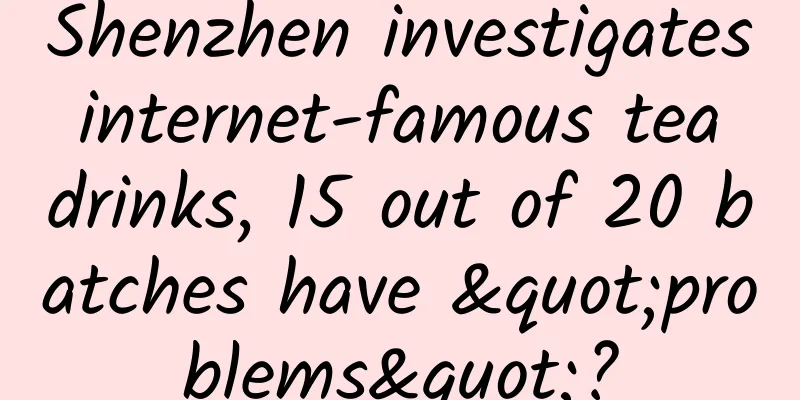Shenzhen investigates internet-famous tea drinks, 15 out of 20 batches have "problems"?

|
With the arrival of summer, many young people love to take photos and check in on social media for "Thai lemon tea", which has also attracted the attention of market supervision departments. According to media reports on June 27, the Shenzhen Municipal Market Bureau found that 15 out of 20 batches of samples contained excessive amounts of the food additive sunset yellow when conducting special sampling inspections on "Thai tea" and other popular online drinks. When you find a common problem, the first thing you should think about is, is this an "unspoken rule"? Is it a mistake? What other possible reasons are there? First of all, the so-called "exceeding the scope of use" is not necessarily true. According to media reports, the Shenzhen Market Bureau only detected sunset yellow in random inspections, which cannot lead to the conclusion of "exceeding the scope of use". According to my country's food safety standards, sunset yellow is indeed not approved for use in tea beverages, but is the variety sampled tea beverage? This remains to be confirmed. Moreover, applying food safety standards to the catering industry is itself a relatively vague area. I just want to ask you whether Kung Pao Chicken can use sunset yellow? There is also a "bring-in principle" for food additives. Considering the difficulty of actual operation, it is unlikely that tea shops will add colorants themselves, because it is difficult to control the amount of addition and quality control will be troublesome, so it is most likely that they will be brought in from some standardized ingredients. And this can also explain why 15 out of 20 batches are "problematic", maybe the supplier is the same? Do these Thai teas use flavored syrups? Do they use pre-made tea base (solid beverages) or other ingredients? This requires regulators to identify according to the actual situation. Media reports say that the Shenzhen Market Bureau has filed a case against 15 tea drinking companies that failed the test, and at the same time guided catering companies to do a good job in quality management and immediately remove and destroy unqualified products. Based on the above, in my personal opinion, is the "unqualified" conclusion really certain? If it is a misjudgment, does removing and destroying the products involve "food waste"? If sunset yellow is really used beyond the scope, what health hazards will it cause? In the media reports, a doctor's point of view was quoted: Long-term or one-time consumption of foods with excessive pigment content may cause allergies, diarrhea and other symptoms. When the intake is too large and exceeds the liver's load, it will accumulate in the body and cause certain damage to the kidneys and liver. I really can't stand this paragraph. I have repeatedly stressed 10,086 times that when it comes to food safety, the words of most doctors cannot be trusted. The so-called long-term, large amounts, exceeding the standard, possible, excessive, accumulation, and certain harm are all groundless clichés. This paragraph is actually from Baidu Encyclopedia, with almost no changes. Pigments are typical "self-limiting" additives. It is difficult to use excessive amounts in beverages, otherwise the color will be too dark and the appearance will be bad. Just think about those retro "three-spirit waters", which are already very dark in color but have not exceeded the standard. How can there be a possibility of long-term exceeding the standard? Secondly, as a pigment, sunset yellow is added in very small amounts, and the sunset yellow eaten is hardly absorbed. How can it be accumulated? How can it cause liver and kidney damage if it is not absorbed? When approving food additives, the possibility of daily consumption throughout life has been fully considered, and sufficient safety margins have been left. It is basically impossible to have problems with eating them, not to mention a "self-limiting" pigment? (Similar to sweeteners, flavors and fragrances, etc.) In short, there is nothing wrong with strengthening the supervision of restaurants, as they have many more risk points than food factories. However, the core of restaurant safety is hygiene, and as long as there are no foodborne diseases, it is not a big deal. For restaurant operators, abiding by the law is the most basic requirement, and it is absolutely necessary to learn about food-related laws and regulations, otherwise it is easy to suffer losses. |
Recommend
If there is always thick phlegm in your throat, be careful that you may have allergic pharyngitis!
Author: Lin Lin, Chief Physician, Huashan Hospita...
What is the cause of persistent moderate vaginal bleeding?
Many women are very concerned about their physica...
The harm of women crossing their legs
What are the dangers of women crossing their legs...
How to treat endocrine disorders in women
How to treat women's endocrine disorders is s...
How to replenish anemia in late pregnancy
The most common type of anemia in late pregnancy ...
What are the ways to treat dysmenorrhea?
Dysmenorrhea is a condition that many women often...
Unexpected pregnancy, medical abortion and surgical abortion, how to choose
Many female friends, due to their own reasons, do...
Are cervical warts serious?
Genital warts are a sexually transmitted disease ...
What to do if milk is blocked
Every woman will face the situation of getting ma...
How to make French fries less greasy? Will eating French fries make you fat?
French fries themselves are not "body killer...
Can I do IVF without a uterus?
The uterus is an important organ in the female re...
Can moxibustion treat cervical erosion?
Cervical erosion is a common physical disease in ...
How to treat cervical erosion fastest
Cervical erosion is a common gynecological diseas...
Can I test for pregnancy with only my morning urine?
Pregnancy is great news for newlyweds, as it mean...
I am taking medicine to prevent blood clots, and bruises appear on my skin. Do I need to stop taking the medicine?
A friend consulted Huazi. After taking anti-throm...









